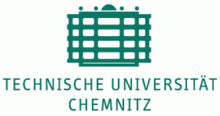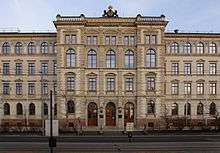Chemnitz University of Technology
|
Technische Universität Chemnitz | |
 | |
| Type | Public |
|---|---|
| Established | 1836 |
| Budget | € 178.1 million[1] |
| Chancellor | Eberhard Alles |
| President | Gerd Strohmeier |
Academic staff | 1,468[1] |
Administrative staff | 808[1] |
| Students | 11,406[1] |
| Location | Chemnitz, Saxony, Germany |
| Website | www.tu-chemnitz.de |

Chemnitz University of Technology (German: Technische Universität Chemnitz, abbreviated TU Chemnitz) is a public university in Chemnitz, Germany. With over 11,000 students, it is the third largest university in Saxony. It was founded in 1836 as Königliche Gewerbeschule (Royal Mercantile College) and was elevated to a Technische Hochschule, a university of technology, in 1963. With approximately 1,500 employees in science, engineering and management, TU Chemnitz counts among the most important employers in the region.
History
Foundation
The tradition of science in this region goes back to the 16th century when Georg Agricola (1494-1555), a famous German scholar of minerals, served as the city's mayor. In 1836, the Royal Mercantile College was established as a scientific base to support the industrial revolution. In 1882 more than 1,000 students registered at the college. Modern scientific areas like electrical engineering were included in the curriculum. These developments made it possible for the institution to become a Königliche Gewerbeakademie (Royal Technical Academy). This academy played a major role in helping Chemnitz to become one of the industrial centers at the beginning of the 20th century. At this time Chemnitz had the highest number of patent registrations in the whole of Germany and hence also in the whole world.[2]
During the German Democratic Republic Era
The city of Chemnitz and the Technical Academy was heavily damaged during the World War II. In the German Democratic Republic era, after some time of adaptation to the new conditions, the status of a Technische Hochschule was awarded in 1963. At the end of the 1960s, the university was composed of faculties for mathematics, natural sciences, engineering and humanities. With the rising number of students, the institution became a Technische Universität in 1986.
After Germany's Reunification

At the end of the German Democratic Republic, the academic system of Eastern Germany was absorbed by the West German system. Chemnitz University of Technology was actively supported to remain as a third university in Saxony besides University of Leipzig and TU Dresden. Therefore, in 1992 and 1993 two new faculties were established: The Faculty of Economics and Business Administration and the Faculty of Humanities and Social Sciences expanded the university's field of studies. These new faculties started to work on interdisciplinary projects with the established faculties of science and engineering and introduced joint degree programs. Within a few years, the number of students doubled to the current level of around 10,000.
Organization and administration
Faculties
The university is organised into the following eight faculties:
- Faculty of Computer Science
- Faculty of Economics and Business Administration
- Faculty of Electrical Engineering and Information Technology
- Faculty of Mathematics
- Faculty of Mechanical Engineering
- Faculty of Natural Sciences
- Faculty of Humanities
- Faculty of Behavioural and Social Sciences
Campus
The Smart Systems Campus, which was built very near the university campus, is now the location of the Institute of Physics, including a cleanroom at the Centre for Microtechnologies, the Fraunhofer Institute for Electronic Nano Systems, and a building providing office space for startups and industrial real estate.
The ancient industrial building Alte Aktienspinnerei ('Old Spinning Mill') will be reconstructed and serve as the location for the Central University Library. Other university institutions will also be relocated along the tram route within the reorganization of the public transport system in Chemnitz according to the so-called 'Chemnitz Model'.
Academic profile
In winter term 2013/2014 about 2,500 young people started their bachelor's or master's degree studies at TU Chemnitz. All in all, the university offers 35 bachelor's and 50 master's degree programs. On the international level TU Chemnitz cooperates with 126 partner institutions in 39 countries. This includes 19 members of the international university network Academic Consortium for the 21st Century (AC21). TU Chemnitz is supported by the Federal Ministry of Education and Research within the project 'Teaching Quality Pact' as well as by Saxony's Centre for Teaching and Learning funded by the Saxon State Ministry of Science and the Arts.
Research
The university has concentrated its research to six main profiles:
- New materials
- Production Life Cycle
- Microelectronics & Micro-electromechanical systems
- Applications & development of systems
- Communications, Media, Technology
- Modeling, Simulation, High Performance Computing
Furthermore, TU Chemnitz runs the following research centers:
- ALT - Allianz Textiler Leichtbau
- Chemnitzer Initiative Technologien für die Elektromobilität
- CATI - Chemnitzer Automative Institute
- Interdisziplinäres Zentrum für Fahrerassistenzsysteme
- Interdisziplinäres Zentrum für Hochleistungsrechnen
- Innovationslabor Faserkunststoffverbunde mit integrierter Zustandsüberwachung in Echtzeit
- Interdisziplinäres Forschungslabor für eingebettete, selbstorganisierende Hardware / Software Systeme
- Kompetenzzentrum „Virtual Humans“
- Kompetenzzentrum Maschinenbau Chemnitz / Sachsen
- Kompetenzzentrum „Self-organizing Energy Efficient Driving Assistance and Communication“
- Zentrum für Integrative Leichtbaulösungen
- Zentrum für Mikrotechnologien
A key research area 'Energy-efficient Production Processes' stands the Federal Cluster of Excellence 'Merge Technologies for Multifunctional Lightweight Structures' (MERGE). Funded with €34 million, this cluster is the only one in Germany focusing on the field of lightweight engineering. The breeding ground for this cluster was prepared by the Saxon State Cluster of Excellence 'Energy-efficient Product and Process Innovations in Production Engineering' (eniPROD), which was jointly established with the Fraunhofer Institute for Machine Tools and Forming Technology. These initiatives are complemented by additional collaborative research areas funded by Deutsche Forschungsgemeinschaft (DFG) which develop intelligent materials and energy-efficient production technologies.
Within the key research area 'Smart Systems and Materials', scientists at TU Chemnitz are also involved in the Federal Cluster of Excellence 'Center for Advancing Electronics Dresden' (cfAED). Further input is provided by the Nano System Integration Network of Excellence (Nanett), funded by the Federal Government, as well as by the cluster COOL SILICON 'Energy Efficiency Innovations from Silicon Saxony'. Several DFG Research Groups are working in this field. In addition, TU Chemnitz will be the home of the 'Center for Materials, Architectures and Integration of Nanomembranes' (MAIN).
Entrepreneurship
TU Chemnitz collaborates with companies and research institutions in the so-called Wissenschaftsregion Chemnitz ('science region Chemnitz'). Active support for entrepreneurs is provided by the Technology Center Chemnitz and SAXEED, the startup incubator of TU Chemnitz, Freiberg University of Mining and Technology, Hochschule Mittweida, and Westsächsische Hochschule Zwickau. With their assistance, 168 spin-offs were established generating about 800 jobs.
International students
Chemnitz University of Technology has a large body of foreign students. In winter semester 2017, out of its 10,482 students, 2,712 were foreign students, which equals to about 25%.[3]
Notable people
Professors
References
- 1 2 3 4 "Fakten und Zahlen". Technische Universität Chemnitz (in German). Retrieved 2017-06-12.
- ↑ "University Portrait: Chemnitz University of Technology (German)". Frankfurter Allgemeine Zeitung. 2005.
- ↑ "Statistical Office of Saxony, Statistical data of June 2018 for academic winter term 2017" (PDF).
External links
Coordinates: 50°48′49″N 12°55′45″E / 50.81361°N 12.92917°E